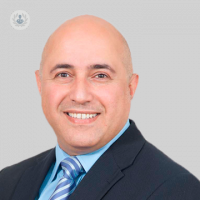Aquablation for benign prostatic hyperplasia (BPH)
Autore:Benign prostatic hyperplasia (BPH), characterised by an enlarged prostate gland, is a common condition affecting many men as they age, often leading to bothersome urinary symptoms. While traditional surgical interventions have been the mainstay of treatment, a newer approach called Aquablation therapy is gaining attention for its precision and minimal invasiveness. In his latest online article, Mr Aza Mohammed gives us his insights.

What is Aquablation?
Aquablation therapy is a cutting-edge surgical technique designed to alleviate lower urinary tract symptoms caused by BPH. Unlike traditional methods that use heat to remove prostate tissue, Aquablation employs a high-velocity waterjet under real-time ultrasound guidance. This combination allows for precise and efficient removal of excess prostate tissue, aiming to improve urinary flow and reduce symptoms.
How does Aquablation differ from other treatments for BPH?
Aquablation stands out due to its unique approach:
- Precision: Real-time ultrasound imaging enables accurate targeting and removal of prostate tissue.
- Heat-free: Unlike procedures that use heat, Aquablation minimises the risk of complications such as sexual dysfunction or urinary incontinence.
- Effectiveness: Clinical studies have demonstrated significant symptom relief with low complication rates, making it a promising option for patients.
Benefits of Aquablation over traditional surgical methods
Aquablation offers several advantages:
- Safety: By avoiding thermal injury, Aquablation reduces the risk of side effects commonly associated with heat-based procedures.
- Efficiency: The procedure is quick, with reduced operative times compared to traditional methods.
- Preservation of sexual function: Minimising damage to surrounding tissues helps preserve sexual function post-surgery.
- Short learning curve for surgeons: Training requirements for performing Aquablation are typically less extensive compared to other advanced surgical techniques.
How is Aquablation performed?
The procedure involves several key steps:
- Preparation: Patients may undergo general or regional anaesthesia based on medical assessment.
- Imaging and planning: Ultrasound and cystoscopy are used to visualise the prostate and create a personalised treatment plan.
- Tissue removal: A robotic arm delivers a precise, high-velocity waterjet to remove excess prostate tissue while minimising damage to adjacent structures.
- Completion: Post-procedure, bleeding points are cauterised, and a temporary catheter may be inserted briefly to aid healing.
Anaesthesia and duration
Aquablation can be performed under general or spinal anaesthesia, ensuring patient comfort throughout the brief procedure, which typically lasts only a few minutes.
Alternatives to aquablation
For individuals seeking alternatives:
- Conservative measures: Lifestyle adjustments like fluid management.
- Medication: Drugs such as tamsulosin or finasteride may alleviate symptoms.
- Surgical options: Traditional methods like TURP (Transurethral Resection of the Prostate), HoLEP (Holmium Laser Enucleation of the Prostate), or laser-based treatments remain viable choices for some patients.
Mr Aza Mohammed is an esteemed urologist. You can schedule an appointment with Mr Mohammed on his Top Doctors profile.


